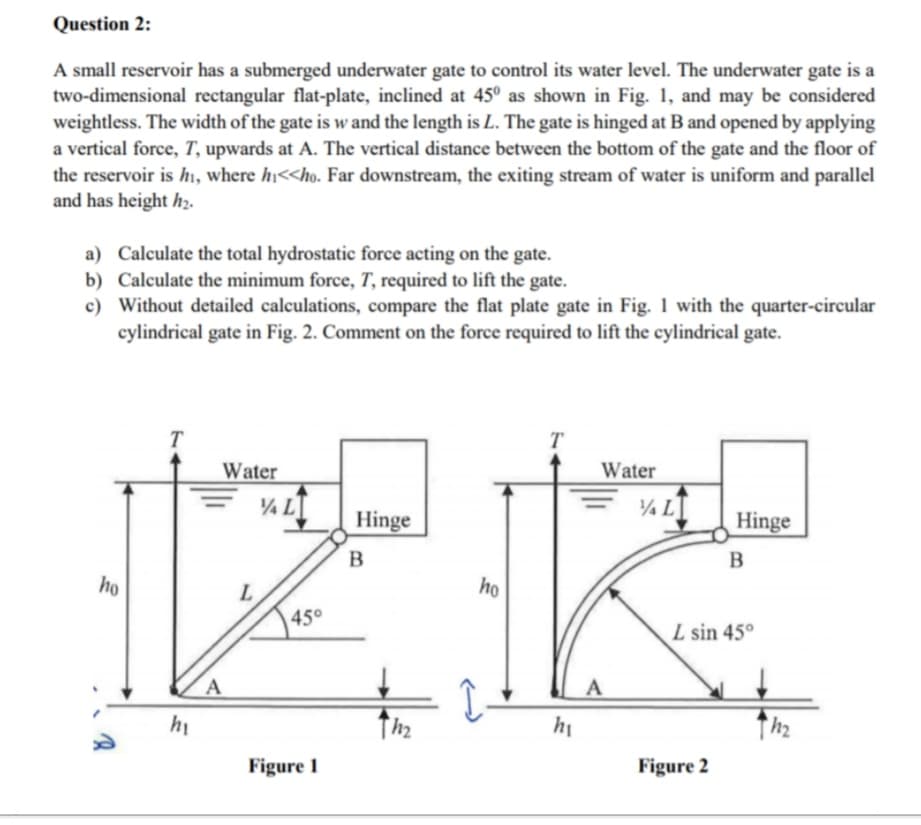A small reservoir has a submerged underwater gate to control its water level. The underwater gate is a two-dimensional rectangular flat-plate, inclined at 45° as shown in Fig. 1, and may be considered weightless. The width of the gate is w and the length is L. The gate is hinged at B and opened by applying a vertical force, T, upwards at A. The vertical distance between the bottom of the gate and the floor of the reservoir is hi, where hi<
A small reservoir has a submerged underwater gate to control its water level. The underwater gate is a two-dimensional rectangular flat-plate, inclined at 45° as shown in Fig. 1, and may be considered weightless. The width of the gate is w and the length is L. The gate is hinged at B and opened by applying a vertical force, T, upwards at A. The vertical distance between the bottom of the gate and the floor of the reservoir is hi, where hi<
Elements Of Electromagnetics
7th Edition
ISBN:9780190698614
Author:Sadiku, Matthew N. O.
Publisher:Sadiku, Matthew N. O.
ChapterMA: Math Assessment
Section: Chapter Questions
Problem 1.1MA
Related questions
Topic Video
Question

Transcribed Image Text:Question 2:
A small reservoir has a submerged underwater gate to control its water level. The underwater gate is a
two-dimensional rectangular flat-plate, inclined at 45° as shown in Fig. 1, and may be considered
weightless. The width of the gate is w and the length is L. The gate is hinged at B and opened by applying
a vertical force, T, upwards at A. The vertical distance between the bottom of the gate and the floor of
the reservoir is h, where hị<<ho. Far downstream, the exiting stream of water is uniform and parallel
and has height hz.
a) Calculate the total hydrostatic force acting on the gate.
b) Calculate the minimum force, T, required to lift the gate.
c) Without detailed calculations, compare the flat plate gate in Fig. 1 with the quarter-circular
cylindrical gate in Fig. 2. Comment on the force required to lift the cylindrical gate.
T
T
Water
Water
¼ L
¼ L
Hinge
Hinge
B
B
ho
ho
45°
L sin 45°
hi
hi
Figure 1
Figure 2
Expert Solution
This question has been solved!
Explore an expertly crafted, step-by-step solution for a thorough understanding of key concepts.
Step by step
Solved in 4 steps with 1 images

Knowledge Booster
Learn more about
Need a deep-dive on the concept behind this application? Look no further. Learn more about this topic, mechanical-engineering and related others by exploring similar questions and additional content below.Recommended textbooks for you

Elements Of Electromagnetics
Mechanical Engineering
ISBN:
9780190698614
Author:
Sadiku, Matthew N. O.
Publisher:
Oxford University Press

Mechanics of Materials (10th Edition)
Mechanical Engineering
ISBN:
9780134319650
Author:
Russell C. Hibbeler
Publisher:
PEARSON

Thermodynamics: An Engineering Approach
Mechanical Engineering
ISBN:
9781259822674
Author:
Yunus A. Cengel Dr., Michael A. Boles
Publisher:
McGraw-Hill Education

Elements Of Electromagnetics
Mechanical Engineering
ISBN:
9780190698614
Author:
Sadiku, Matthew N. O.
Publisher:
Oxford University Press

Mechanics of Materials (10th Edition)
Mechanical Engineering
ISBN:
9780134319650
Author:
Russell C. Hibbeler
Publisher:
PEARSON

Thermodynamics: An Engineering Approach
Mechanical Engineering
ISBN:
9781259822674
Author:
Yunus A. Cengel Dr., Michael A. Boles
Publisher:
McGraw-Hill Education

Control Systems Engineering
Mechanical Engineering
ISBN:
9781118170519
Author:
Norman S. Nise
Publisher:
WILEY

Mechanics of Materials (MindTap Course List)
Mechanical Engineering
ISBN:
9781337093347
Author:
Barry J. Goodno, James M. Gere
Publisher:
Cengage Learning

Engineering Mechanics: Statics
Mechanical Engineering
ISBN:
9781118807330
Author:
James L. Meriam, L. G. Kraige, J. N. Bolton
Publisher:
WILEY